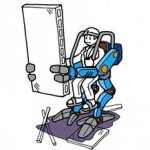Archive for 2009
Искусственную руку «научили» осязанию
- Тип контента: Новостная статья
- Номер документа: 4712
- Название документа: Искусственную руку "научили" осязанию
- Номер (DOI, IBSN, Патент): Не заполнено
- Изобретатель/автор: Не заполнено
- Правопреемник/учебное заведение: Не заполнено
- Дата публикации документа: 2009-10-23
- Страна опубликовавшая документ: Россия
- Язык документа: Русский
- Наименование изделия: Не заполнено
- Источник: http://www.3dnews.ru/news/iskusstvennuu_ruku_nauchili_osyaza
- Вложения: Не заполнено
- Аналитик: Helix
 Проект Smart Hand («Интеллектуальна рука») – это разработка исследователей из Университета Лунда (Lund University) в Швеции и Института прогрессивных исследований св. Анны (Scuola Superiore Sant’Anna) в Италии. Благодаря роботизированному протезу Робину Экенстаму (Robin af Ekenstam) теперь доступно чувство осязания для обеих рук.
Проект Smart Hand («Интеллектуальна рука») – это разработка исследователей из Университета Лунда (Lund University) в Швеции и Института прогрессивных исследований св. Анны (Scuola Superiore Sant’Anna) в Италии. Благодаря роботизированному протезу Робину Экенстаму (Robin af Ekenstam) теперь доступно чувство осязания для обеих рук.
Категория: Управление | Нет комментариев »
Passive gravity-balanced assistive device for sit-to-stand tasks
- Тип контента: Патент
- Номер документа: 4565
- Название документа: Passive gravity-balanced assistive device for sit-to-stand tasks
- Номер (DOI, IBSN, Патент): US007601104B2
- Изобретатель/автор: Agrawal, S.K., Catlin G., Fattah, A., Hamnett J.
- Правопреемник/учебное заведение: Univ. of Delaware, Newark, DE, USA
- Дата публикации документа: 2009-10-13
- Страна опубликовавшая документ: США
- Язык документа: Английский
- Наименование изделия: Не заполнено
- Источник: http://www.google.com/patents/US7601104
- Вложения: Да
- Аналитик: Дмитрий Соловьев
 A passive gravity balancing assist device for human sit-to-stand motion is provided. The design combines the use of auxiliary parallelograms with springs to produce an orthotic device wherein the total potential energy of the system is constant during standing and sitting motion.
A passive gravity balancing assist device for human sit-to-stand motion is provided. The design combines the use of auxiliary parallelograms with springs to produce an orthotic device wherein the total potential energy of the system is constant during standing and sitting motion.
Категория: Патенты | Нет комментариев »
В Японии создают экзоскелет для грузчиков
- Тип контента: Новостная статья
- Номер документа: 4670
- Название документа: В Японии создают экзоскелет для грузчиков
- Номер (DOI, IBSN, Патент): Не заполнено
- Изобретатель/автор: Не заполнено
- Правопреемник/учебное заведение: Не заполнено
- Дата публикации документа: 2009-10-01
- Страна опубликовавшая документ: Россия
- Язык документа: Русский
- Наименование изделия: Не заполнено
- Источник: http://infox.ru/hi-tech/tech/2009/10/01/power_loader.phtml
- Вложения: Не заполнено
- Аналитик: Helix
 Инженеры-роботоконструкторы из Японии озаботились тем, как облегчить труд простых грузчиков и спасателей. Именно для них создается экзоскелет Power Loader.
Инженеры-роботоконструкторы из Японии озаботились тем, как облегчить труд простых грузчиков и спасателей. Именно для них создается экзоскелет Power Loader.
Категория: Power Loader | 1 Комментарий »
Dampace: Design of an Exoskeleton for Force- Coordination Training in Upper-Extremity Rehabilitation
- Тип контента: Научная статья
- Номер документа: 7925
- Название документа: Dampace: Design of an Exoskeleton for Force- Coordination Training in Upper-Extremity Rehabilitation
- Номер (DOI, IBSN, Патент): 10.1115/1.3191727
- Изобретатель/автор: Arno H. A. Stienen, Edsko E. G. Hekman, Gerdienke B. Prange, Michiel J. A. Jannink, Arthur M. M. Aalsma, Frans C. T. van der Helm, Herman van der Kooij
- Правопреемник/учебное заведение: University of Twente
- Дата публикации документа: 2009-09-30
- Страна опубликовавшая документ: Нидерланды (Голландия)
- Язык документа: Английский
- Наименование изделия: Не заполнено
- Источник: Journal of Medical Devices
- Вложения: Да
- Аналитик: Глаголева Елена
 The Dampace exoskeleton combines functional exercises resembling activities of daily living with impairment-targeted force-coordination training. The goal of this paper is to evaluate the performance of the Dampace. In the design, the joint rotations are decoupled from the joint translations; the robot axes align themselves to the anatomical axes, overcoming some of the traditional difficulties of exoskeletons. Setup times are reduced to mere minutes and static reaction forces are kept to a minimum. The Dampace uses hydraulic disk brakes, which can resist rotations with up to 50 N m and have a torque bandwidth of 10 Hz for multisine torques of 20 N m. The brakes provide passive control over the movement; the patients’ movements can be selectively resisted, but active movement assistance is impossible and virtual environments are restricted. However, passive actuators are inherently safe and force active patient participation. In conclusion, the Dampace is well suited to offer force-coordination training with functional exercises.
The Dampace exoskeleton combines functional exercises resembling activities of daily living with impairment-targeted force-coordination training. The goal of this paper is to evaluate the performance of the Dampace. In the design, the joint rotations are decoupled from the joint translations; the robot axes align themselves to the anatomical axes, overcoming some of the traditional difficulties of exoskeletons. Setup times are reduced to mere minutes and static reaction forces are kept to a minimum. The Dampace uses hydraulic disk brakes, which can resist rotations with up to 50 N m and have a torque bandwidth of 10 Hz for multisine torques of 20 N m. The brakes provide passive control over the movement; the patients’ movements can be selectively resisted, but active movement assistance is impossible and virtual environments are restricted. However, passive actuators are inherently safe and force active patient participation. In conclusion, the Dampace is well suited to offer force-coordination training with functional exercises.
Категория: Научные статьи | Нет комментариев »
Electromyography (EMG)-signal based fuzzy-neuro control of a 3 degrees of freedom (3DO F) exoskeleton robot for human upper-limb motion assist
- Тип контента: Научная статья
- Номер документа: 6227
- Название документа: Electromyography (EMG)-signal based fuzzy-neuro control of a 3 degrees of freedom (3DO F) exoskeleton robot for human upper-limb motion assist
- Номер (DOI, IBSN, Патент): Не заполнено
- Изобретатель/автор: R.A.R.C. Gopura, Kazuo Kiguchi
- Правопреемник/учебное заведение: Saga University
- Дата публикации документа: 2009-09-25
- Страна опубликовавшая документ: Япония
- Язык документа: Английский
- Наименование изделия: Не заполнено
- Источник: J.Natn.Sci.Foundation Sri Lanka
- Вложения: Да
- Аналитик: Глаголева Елена
 An electromyography (EMG) signal based fuzzy-neuro control method is proposed in this paper for a human upper-limb motion assist exo-skeleton robot. The upper-limb exoskeleton robot (named W-EXOS) assists the motions of human forearm pronation/supination, wrist flexion/extension and ulnar/radial deviation. The paper presents the EMG signal based fuzzy-neuro control method with multiple fuzzy-neuro controllers and the adaptation method of the controllers. The skin surface EMG signals of muscles in the forearm of the exoskeleton user and the hand force/forearm torque measured from the sensors of the exoskeleton robot are used as input information for the controllers. Fuzzy-neuro control method, which is a combination of flexible fuzzy control and adaptive neural network cont-rol, has been applied to realize the natural and flexible motion assist. In the control method, multiple fuzzy-neuro controllers are applied, since the muscle activation levels change in accordance with the angles of motions. The control method is able to adapt in accordance with the changing EMG signal le-vels of different users. Experiments have been performed to evaluate the propo-sed control method.
An electromyography (EMG) signal based fuzzy-neuro control method is proposed in this paper for a human upper-limb motion assist exo-skeleton robot. The upper-limb exoskeleton robot (named W-EXOS) assists the motions of human forearm pronation/supination, wrist flexion/extension and ulnar/radial deviation. The paper presents the EMG signal based fuzzy-neuro control method with multiple fuzzy-neuro controllers and the adaptation method of the controllers. The skin surface EMG signals of muscles in the forearm of the exoskeleton user and the hand force/forearm torque measured from the sensors of the exoskeleton robot are used as input information for the controllers. Fuzzy-neuro control method, which is a combination of flexible fuzzy control and adaptive neural network cont-rol, has been applied to realize the natural and flexible motion assist. In the control method, multiple fuzzy-neuro controllers are applied, since the muscle activation levels change in accordance with the angles of motions. The control method is able to adapt in accordance with the changing EMG signal le-vels of different users. Experiments have been performed to evaluate the propo-sed control method.
Категория: Научные статьи | Нет комментариев »
Статистика
Категорий: 179
Статей всего: 2,003
По типу:
Видео: 36
Выдержка с форума: 1
Контактные данные: 12
Научная статья: 1388
Не заполнено: 5
Новостная статья: 317
Обзор технологии: 42
Патент: 219
Тех.подробности: 34
Тип: 1
Комментариев: 8,689
Изображений: 3,005
Подробней...
ТОР 10 аналитиков
-
Глаголева Елена - 591
Дмитрий Соловьев - 459
Helix - 218
Ридна Украина))) - 85
Наталья Черкасова - 81
max-orduan - 29
Елена Токай - 15
Роман Михайлов - 9
Мансур Жигануров - 4
Дуванова Татьяна - 3
Календарь
| Пн | Вт | Ср | Чт | Пт | Сб | Вс |
|---|---|---|---|---|---|---|
| « Ноя | ||||||
| 1 | 2 | 3 | 4 | 5 | ||
| 6 | 7 | 8 | 9 | 10 | 11 | 12 |
| 13 | 14 | 15 | 16 | 17 | 18 | 19 |
| 20 | 21 | 22 | 23 | 24 | 25 | 26 |
| 27 | 28 | 29 | 30 | 31 | ||
Авторизация
Ошибка в тексте?
Выдели её мышкой!
И нажми Ctrl+Enter